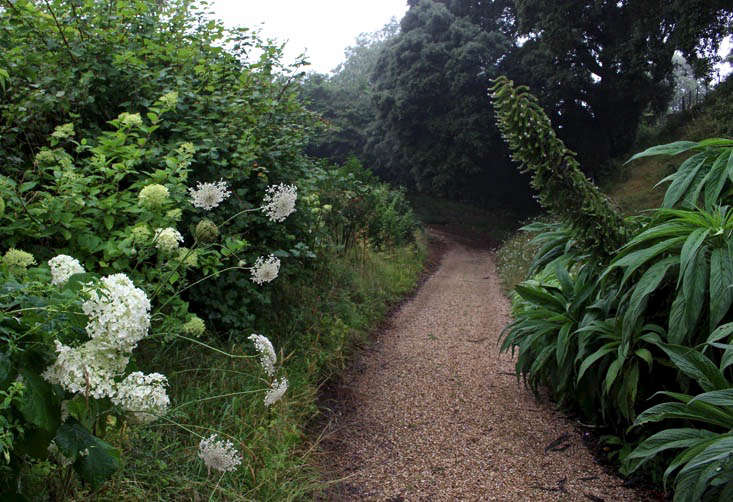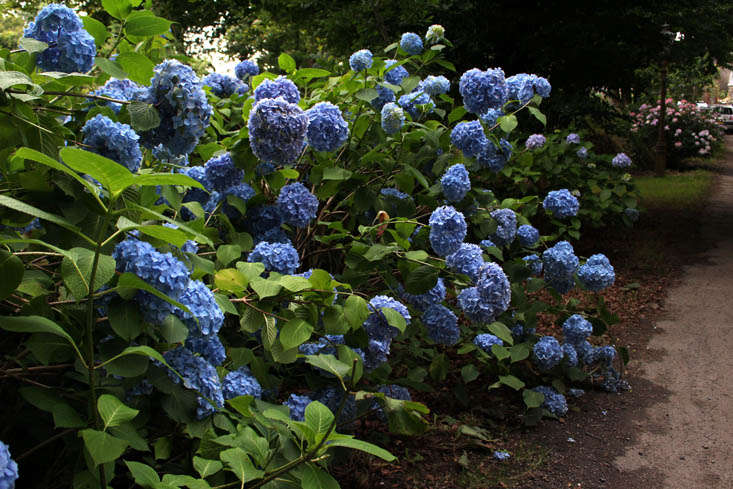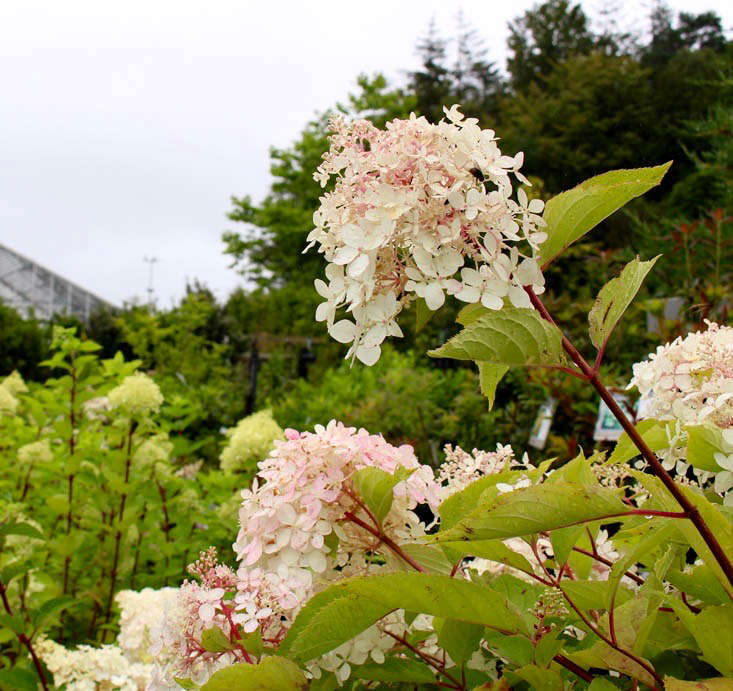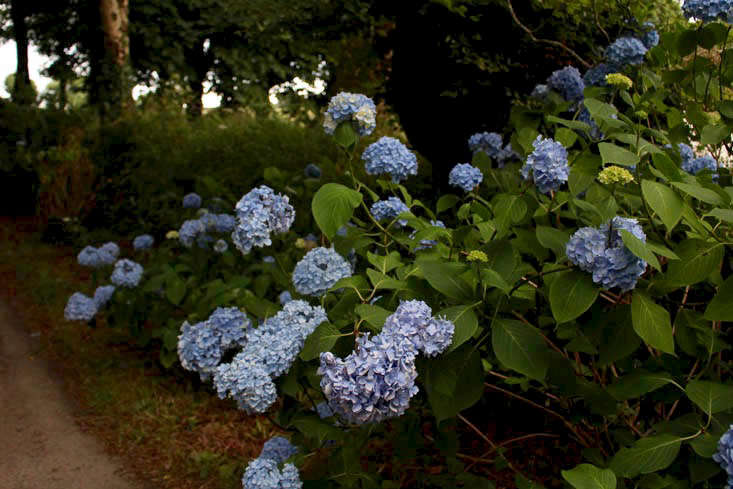This week, we are revisiting some of our favorite summer-centric Gardenista stories. Remember this one?
Hydrangeas suffer from the same image problem as rhododendrons: they are usually in the wrong place. A pot near the house requires ericaceous soil, an acid mulch, aluminum sulphate. They look constrained, too neat.
Hydrangeas take on a magnificence when they have freedom, grown in a place that they actually like. Along the narrow lanes of Cornwall, at the southwest tip of England, hydrangeas are the most otherworldly of plants. In shades of electric blue or a peculiar purple or greenish white, they emerge from the shade of lichen-covered holm oaks, glowing against slate walls.
Says Alasdair Moore of the Duchy Nursery in Lostwithiel: “In Cornwall, hydrangeas have made themselves at home, often looking particularly wild with their drooping stems laden with flower.”
Here are seven garden design ideas for wild hydrangeas:
Photography by Kendra Wilson.
1. Blanket a slope.
Above: At Trematon Castle at the edge of Cornwall, the croquet lawn by the house falls away into a jungle of greenery. Hydrangeas grow up the slope, unsupported, among roses and herbs. In a light rain, their mopheads carry the weight.
Cornish “mizzle,” the misty moisture which characterizes the coastal weather when it is not radiantly sunny, enhances the effect.
2. Grow a jungle.
Above: At Trematon, home of garden designers Isabel and Julian Bannerman, hydrangeas become jungle plants. Here, Hydrangea arborescens ‘Annabelle’ is joined by the white umbels of Ammi majus, with spires of Echium pininana on the other side of the path.
3. Encroach on a driveway.
Above: Blue macrophylla hydrangeas growing along parts of the driveway at Botelet Farm, in southeast Cornwall.
Try as one might, it’s impossible not to think of the novels of Daphne du Maurier when traveling in Cornwall, especially after being lost for what seems like hours. It is the wildness of ordinary plants that bring the famous opening line of Rebecca to mind: “Last night I dreamt I went to Manderley again.”
4. Dispel gloom.
Above: Untroubled by bluing agents and soil acidity test kits, hydrangeas glint in the gloom, in the way that rhododendrons can, if they are allowed to.
“Many of the hydrangeas in Cornwall have a genuine and precise sense of place,” says Alasdair Moore. “Their shades of blue are dependent on the soil they find themselves in, acidity allowing them to take up aluminum which gives them the blueness.”
5. Keep them moist.
Above: Hydrangea paniculata ‘Sundae Fraise’ at the Duchy Nursery in Lostwithiel, Cornwall. Paniculata and arborescens types are dependent not on acidity but moisture: they must never dry out.
6. Mix and match.
Above: At Botelet Farm again (which has wonderful cottages to rent as well as a farmhouse bed and breakfast), purple lacecaps grow among the blue mopheads. Hydrangea macrophylla ‘Blue Wave’ is a similar variety to this and can be found at the Duchy Nursery. It is either blue or purple depending on the soil.
7. Design for twilight.
Above: Back to hyper-reality. “I drove home from an evening cricket match last night, down an avenue of big, blue macrophylla hydrangeas,” recalls our friend Alasdair. “Illuminated by my headlights against the night, they looked astounding. It felt as though I was in a dream…” We say: Dream on.
For more design ideas to elevate hydrangeas from cliché to chic, see:
N.B.: This post was first published August 2016.
(Visited 6,606 times, 2 visits today)
Frequently asked questions
What are wild hydrangeas?
Wild hydrangeas refer to the species of hydrangea plants that are native to North America. They are known for their hardiness and ability to grow in a variety of climates.
What are the different ways to incorporate wild hydrangeas in landscaping?
There are several ways to incorporate wild hydrangeas in landscaping: 1) Plant them as a backdrop or focal point in a garden bed. 2) Use them as a natural hedge or privacy screen. 3) Create a border or edging with wild hydrangeas. 4) Grow them in containers for a patio or balcony garden. 5) Plant them along a pathway or walkway. 6) Incorporate them in a mixed perennial or shrub border. 7) Use their cut flowers in floral arrangements.
What are the recommended growing conditions for wild hydrangeas?
Wild hydrangeas prefer moist, well-draining soil and partial shade. They can tolerate full sun in cooler climates but may require more water in hot regions. These plants are adaptable to various soil types but generally thrive in rich, loamy soil. Regular watering and mulching are beneficial for their growth.
How do you care for wild hydrangeas?
To care for wild hydrangeas, make sure to water them regularly, especially during dry spells. Apply a layer of organic mulch around the base of the plants to help retain moisture and control weeds. Prune them in late winter or early spring to remove dead wood and shape the plants. Avoid heavy pruning as it may reduce blooming.
Can wild hydrangeas be grown in containers?
Yes, wild hydrangeas can be grown in containers. Use a well-draining potting mix and ensure the containers have drainage holes. Place the containers in a location that receives partial sun. Water the plants regularly and feed them with a slow-release fertilizer according to the package instructions.
Do wild hydrangeas attract pollinators?
Yes, wild hydrangeas are known to attract pollinators such as bees and butterflies. Their large, showy flowers provide a valuable source of nectar and pollen for these beneficial insects.
Can wild hydrangeas be propagated?
Yes, wild hydrangeas can be propagated through various methods, including stem cuttings and division. Take stem cuttings in early summer and root them in a potting medium. For division, dig up an established plant in early spring, separate the clumps, and replant them in suitable locations.









